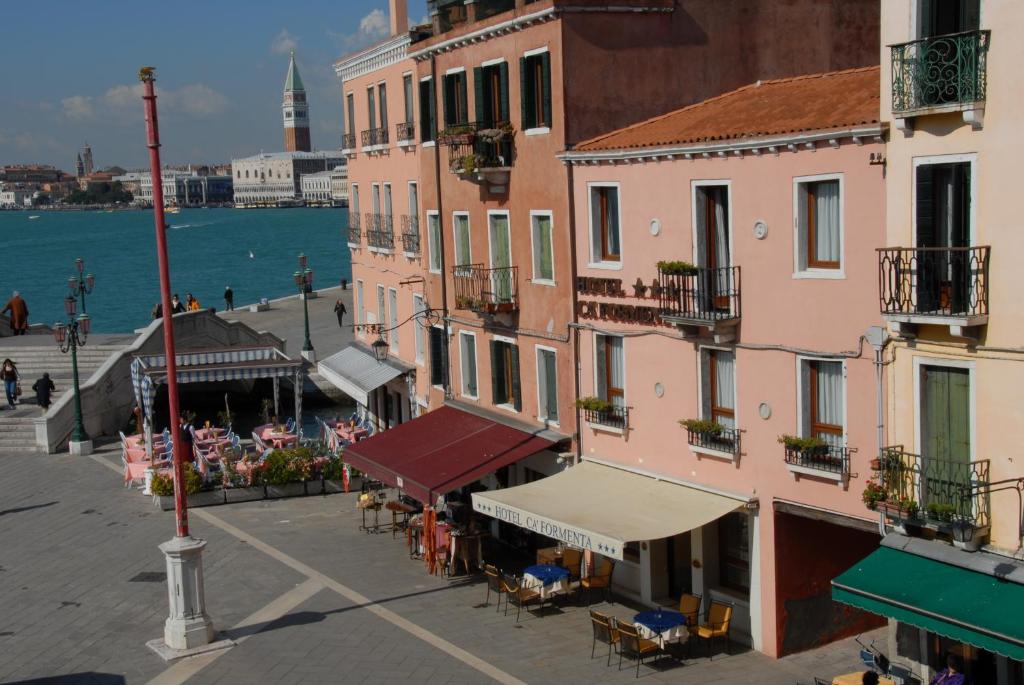The hotel Cà Formenta, which was completely rebuilt from 2002 to 2003 in the heart of Venetian activity, is located at the start of Via Garibaldi in a lively district. According to Tassini in his “Venetian Curiosity,” the Building’s origin dates back to 1400 and that it also had a “Grande Cancelliere della Serenissima” around 1580.
The palazzetto, which was originally covered with a coat of arms depicting three ears of corn, the emblem of the Formenti family, is still used as our logo. During restoration, the management at Panorama Hotel on the Lido was inspired by it and also upgraded it to four-star quality. The restoration project was carried out by G.R. Pantha in Padua architect. They’ve tried to keep it Venetian while adding elegant furniture to it.
For your comfort and convenience, our rooms come with air conditioning (for Summer or Winter), satellite color television, direct telephone connection for personal computers, minibar, personal safe and hair dryer.
The hotel has an elevator for each floor and all public areas are air conditioned. Some rooms havea view of the lagoon. The hotel’s private wharf on the Rio della Tana is very useful for motorboat taxis; it is especially convenient since there are no other hotels with similar facilities in Barile.
Rooms
Every room in the building is fitted with its own air conditioner, direct phone connection for PCs and laptops, minibar, personal safe, and hairdryer. Each floor can be accessed by lift. Many rooms also offer stunning views of the lagoon. Our rooms come in different sizes but they allensure a high level of comfort; some have marble floors and either showers or bathtubs (or both).
For larger families, we also have an apartment with two interconnecting rooms, both equipped with their own bathroom and a lagoon view. If you’re ever feeling lost or needing suggestions during your visit to our lovely city, our Concierge will be more than happy to help you out with anything you need and even provide you with maps. He can recommend restaurants for romantic dates or supper, get tickets for classical music concerts happening soon, suggest excursions to the islands of the Lagoon–anything! Basically, we want your stay here in Venice be as relaxing and unforgettable as possible.
Location
The hotel Cà Formenta is at the end of Via Garibaldi, and it is accessible from both Marco Polo Airport and Santa Lucia Railway Station. Because we have our own dock, we prefer visitors to arrive by motorboat taxi since it is a little more expensive (about € 80.00 from the airport and € 45.00 from the station), but it is unquestionably the more picturesque and convenient option. Alternatively, you may take public transportation to the airport; every hour on the hour, “Alilaguna” departs.
Arsenale, the closest stop to our hotel, is only two bridges away. If you’re arriving from Santa Lucia Train Station or Piazzale Roma on line 51 or 61 of ACTV, get off at Giardini pier and walk across the first bridge on your left. Continue down Riva dei Sette Martiri past the hotel until you reach it by taking ACTV line 1 for a 45-minute trip along the Grand Canal straight to Arsenale (after St. Mark’s Square). Our Stop is immediately after the two bridges!
If you’re looking for an authentic experience away from selfie-stick yielding tourists, head on over to Via Garibaldi! As the heart of Venetian life, Via Garibaldi has not yet been overrun by tourists like many other areas around St. Mark’s Square. The coffee houses and famous restaurants here are mostly populated by locals who come to escape the tourist traps nearby. Just ten minutes away from all the craziness, one can find tranquility and art at the “Padiglioni” of the International Biennale Exhibition of Modern Art – a must for any art lover visiting Venice.
INTEREST POINTS close to HOTEL CA’ FORMENTA!
Saint Mark’s Basilica: The elegant Venetian church with five domes, which resembles the ancient church of Costantinopolis. It was restored during the early centuries of the previous millennium, especially in the thirteenth century, when Venice dominated Mediterranean culture and economy. The temple, built to symbolize Serenissima’s might, is externally decorated with marble, mosaics, and bas-reliefs: all carved from valuable materials came from Ravenna, Bisanzio, and Aquileia. The church has a Greek cross layout with dome-supported columns inside.
Saint Pietro’s Basilica: Saint Mark’s Basilic was the cathedral of Venice until 1807, when it become the religious center of the city. San Pietro is a seventh century BC building that was rebuilt and dedicated to Saint Peter by Bishop Magno. The original building can be seen today; however, only part if it is completed due to a remodeling project based on a design by Palladio.
The 8th of January is still a public holiday in Venice, where it is known as the Malaria Day. It was originally designated to commemorate the end of the epidemic in 1630. Antonio Bellucci painted San Lorenzo implorando l’aiuto di Dio per la liberazione di Venezia dalla peste del 1447 at the end of 1600 to commemorate all of the plague epidemics that have thrown Venice and Europe into chaos.
Saint Giorgio’s School: The School was called by the Dalmatian community, who became a corporation in 1451 and were under saints George, Jerome, and Tryphon’s protection.
This school, which was founded in 1451 and is evidence of the Dalmatian (Schiavoni) community’s presence at the time, might not exist today if it weren’t for Jerusalem’s patriarch giving a relic of Saint George to the commander of the Venetian fleet in 1502. Carpaccio was asked to make paintings for saints Agostino, Matteo and Giorgio while he attending the school. Unfortunately, the school – like many others at that time — was shut down because of Napoleon’s rule.
